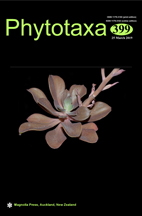Abstract
While the limits of Fimbristylis Vahl (1805: 285) are contentious (Goetghebeur & Coudijzer 1984, Gordon-Gray 1971, Lye 1971, 1973), particularly with regard to the inclusion of Abildgaardia Vahl (1805: 296) within Fimbristylis, all current data support the derivation of Crosslandia W.Fitzg. (1906: 9) from within Fimbristylis (Ghamkhar et al. 2007; Hinchliff & Roalson 2013, Reutemann et al. 2018, Semmouri et al. 2018, Roalson et al. 2019). Crosslandia was described as a monotypic genus in 1906 by Fitzgerald, with more details provided in 1918, where he distinguished Crosslandia from Fimbristylis in having monoecious spikelets and “…the position and structure of the female spikelets.” This is clearly a specialized, derived condition from the typically hermaphroditic flowers in monomorphic spikes of Fimbristylis, and it is not, in itself, particularly surprising that monoecy has been derived within Fimbristylis. This has been found in other Cyperaceae genera, including Eleocharis Brown (1810: 224) where there are multiple species with dimorphic inflorescences with monoecious spikes derived from the more typical hermaphroditic flowers in monomorphic spikes (Roalson et al. 2010). In addition, Clarke (2005) found that monoeicy is not always present in specimens referred to Crosslandia setifolia. For these reasons, we provide a new name in Fimbristylis to replace Crosslandia setifolia W.Fitzg. (1906: 9).

